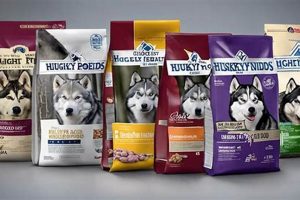Selecting optimal nourishment for a young Siberian Husky is critical to support its rapid growth and development. This food should provide a balanced blend of proteins, fats, carbohydrates, vitamins, and minerals, specifically formulated to meet the unique needs of a growing large-breed canine. An example is a kibble formulated with a higher protein and fat content relative to adult dog food, designed for optimal muscle and bone development.
Providing appropriate nutrition during the puppy stage significantly influences a Husky’s long-term health, impacting factors such as immune system strength, coat quality, and joint health. Historically, breeders and owners often relied on general-purpose dog food, but specialized puppy formulas are now recognized as superior due to their tailored nutrient profiles. The benefits of using these formulas include improved digestion, enhanced cognitive function, and reduced risk of developmental problems.
The subsequent sections will address key considerations in choosing appropriate nutrition for this breed, including the specific nutrient requirements, recommended feeding guidelines, potential health concerns related to diet, and a comparative analysis of different commercially available options.
Essential Nutritional Guidance for Young Huskies
The following recommendations aim to assist in selecting appropriate nourishment, focusing on meeting the specific developmental requirements of the Siberian Husky during its crucial early stages.
Tip 1: Prioritize Protein Content: Select a food with a high percentage of protein, ideally from animal sources. Protein is essential for muscle development and overall growth in this active breed. A minimum protein content of 22-25% on a dry matter basis is generally recommended.
Tip 2: Monitor Fat Intake: Ensure an adequate fat level to support energy needs and coat health. Siberian Huskies require a moderate level of fat, approximately 15-20% on a dry matter basis, sourced from healthy fats like fish oil or flaxseed.
Tip 3: Choose Breed-Specific or Large-Breed Formulas: Opt for a formula specifically designed for puppies of large breeds. These formulas are formulated to promote slow, steady growth, reducing the risk of developmental orthopedic conditions.
Tip 4: Observe Calcium and Phosphorus Levels: Scrutinize the calcium and phosphorus content to ensure a balanced ratio. Excessive calcium can lead to skeletal issues, especially in fast-growing puppies. A balanced ratio is crucial for healthy bone development.
Tip 5: Supplement with Omega Fatty Acids: Consider supplementing the diet with omega-3 and omega-6 fatty acids. These essential fats support healthy skin and coat, reducing the likelihood of skin allergies or dryness common in the breed.
Tip 6: Avoid Excessive Carbohydrates and Fillers: Limit the presence of excessive carbohydrates and fillers, such as corn, wheat, and soy. These ingredients offer limited nutritional value and can contribute to digestive upset or weight gain.
Tip 7: Adhere to Feeding Guidelines: Strictly follow the recommended feeding guidelines provided by the product manufacturer, adjusted based on individual puppy’s activity level and body condition. Regular monitoring of weight and body condition is essential.
Adhering to these nutritional guidelines promotes optimal health, growth, and development during the critical puppy stage, laying the foundation for a healthy and active adult life.
The next section will delve into potential health considerations and how nutrition plays a role in their prevention and management.
1. Protein Source Quality
Protein source quality constitutes a fundamental determinant in selecting appropriate nourishment for a growing Siberian Husky puppy. The biological value and amino acid profile of the protein significantly impact muscle development, immune function, and overall health. Inadequate protein quality can lead to stunted growth, weakened immune response, and compromised coat condition.
- Amino Acid Profile Completeness
A complete protein source contains all essential amino acids in appropriate proportions. These amino acids, which cannot be synthesized by the puppy’s body, must be obtained through dietary intake. Sources such as chicken, fish, and eggs provide a complete amino acid profile, promoting optimal growth and development. In contrast, plant-based proteins may lack or be deficient in certain essential amino acids, necessitating careful formulation to ensure nutritional adequacy.
- Digestibility and Bioavailability
The digestibility of the protein source influences the extent to which the puppy can absorb and utilize the constituent amino acids. Highly digestible protein sources, such as hydrolyzed protein, are readily broken down and absorbed, maximizing their nutritional value. Conversely, poorly digestible protein sources may result in digestive upset and reduced nutrient absorption, even if the overall protein content is adequate.
- Source Transparency and Traceability
Understanding the origin and processing methods of the protein source is crucial for ensuring quality and safety. Reputable dog food manufacturers provide transparent information about their protein sources, including the species of origin, the processing methods used, and the presence of any potential contaminants. This transparency allows owners to make informed choices and avoid protein sources that may be associated with allergies or sensitivities.
- Muscle Development Impact
High-quality protein directly supports the development and maintenance of lean muscle mass. Siberian Husky puppies require a robust muscle structure to support their active lifestyle. Providing a diet rich in high-quality protein ensures that they have the necessary building blocks for muscle growth and repair, contributing to their overall strength and athleticism.
In summary, prioritizing high-quality protein sources with complete amino acid profiles, excellent digestibility, and transparent sourcing is paramount when choosing a food for a growing Siberian Husky puppy. This approach promotes optimal muscle development, immune function, and overall health, contributing to a long and active life.
2. Fat Content Optimization
Appropriate fat content is crucial when selecting optimal nourishment. The dietary fat level significantly impacts energy supply, nutrient absorption, and overall health for a growing Siberian Husky puppy. Optimizing fat content ensures that the puppy receives adequate energy for its high activity level, facilitates the absorption of fat-soluble vitamins, and supports healthy coat development.
- Energy Density Provision
Fat provides more than twice the energy per gram compared to carbohydrates or protein. Siberian Husky puppies require a high-energy diet to support their rapid growth and active lifestyle. A sufficient fat content, typically between 15-20% on a dry matter basis, ensures that the puppy receives enough calories to fuel its metabolic needs. Inadequate fat intake can result in weight loss, lethargy, and impaired growth.
- Essential Fatty Acid Delivery
Dietary fat serves as a vehicle for delivering essential fatty acids, such as omega-3 and omega-6 fatty acids. These fatty acids cannot be synthesized by the puppy’s body and must be obtained through the diet. Omega-3 fatty acids, particularly EPA and DHA, are crucial for brain development, immune function, and reducing inflammation. Omega-6 fatty acids are important for skin and coat health. A balanced ratio of omega-3 to omega-6 fatty acids is essential for optimal health.
- Fat-Soluble Vitamin Absorption
Fat-soluble vitamins, including vitamins A, D, E, and K, require dietary fat for proper absorption. These vitamins play critical roles in various physiological processes, including vision, bone health, immune function, and blood clotting. Insufficient fat intake can impair the absorption of these vitamins, leading to deficiencies and associated health problems.
- Coat Health and Integrity
Dietary fat contributes to the health and integrity of the puppy’s coat. Essential fatty acids help maintain the skin’s barrier function, preventing dryness and irritation. They also contribute to the production of sebum, an oily substance that lubricates the coat and gives it a healthy sheen. A diet deficient in essential fatty acids can result in a dry, brittle coat that is prone to shedding and matting.
In conclusion, optimizing dietary fat content is essential for providing adequate energy, delivering essential fatty acids, facilitating fat-soluble vitamin absorption, and maintaining coat health in Siberian Husky puppies. Carefully selecting a food with an appropriate fat content and fatty acid profile contributes to their overall health and well-being.
3. Calcium
The calcium-to-phosphorus ratio represents a critical consideration in canine nutrition, particularly when selecting nourishment for a Siberian Husky puppy. Proper skeletal development hinges on maintaining an appropriate balance between these two minerals. Deviation from the recommended ratio can precipitate severe orthopedic conditions, impacting the long-term health and mobility of the animal. For instance, excessive calcium intake coupled with insufficient phosphorus can disrupt bone remodeling, leading to conditions such as osteochondrosis dissecans or hip dysplasia, commonly observed in large-breed canines.
Optimal skeletal health during puppyhood requires a dietary calcium-to-phosphorus ratio typically ranging from 1:1 to 2:1. Commercial puppy food formulated for large breeds is designed to adhere to these guidelines, mitigating the risk of developmental orthopedic disease. Supplementation with calcium, especially when the basal diet is already properly balanced, is generally discouraged, as it can disrupt the delicate mineral balance and prove detrimental. The consequences of imbalances are particularly pronounced in rapidly growing breeds, where bone formation proceeds at an accelerated rate.
In summation, the significance of a balanced calcium-to-phosphorus ratio in a young Husky’s diet cannot be overstated. Failure to address this critical aspect can lead to potentially irreversible skeletal damage. The selection of a commercial food product specifically formulated for large-breed puppies, coupled with vigilant adherence to feeding guidelines and avoidance of unnecessary supplementation, is paramount in promoting healthy skeletal development and minimizing the risk of orthopedic complications throughout the animal’s life.
4. Joint Health Support
Joint health support is a critical factor in selecting appropriate nourishment for a young Siberian Husky. The breed’s inherent activity level and potential predisposition to joint issues necessitate a diet that proactively addresses and maintains the integrity of its musculoskeletal system.
- Glucosamine and Chondroitin Supplementation
Glucosamine and chondroitin are naturally occurring compounds within cartilage. Supplementation with these substances aims to support cartilage health and potentially mitigate the progression of osteoarthritis. In the context of selecting optimal puppy food, the inclusion of these supplements may offer preventative benefits, particularly for a breed known for its energetic lifestyle and susceptibility to joint stress. For example, some commercially available puppy foods incorporate specific levels of glucosamine and chondroitin to support healthy joint development during the critical growth phase.
- Omega-3 Fatty Acids and Anti-Inflammatory Effects
Omega-3 fatty acids, particularly EPA and DHA, possess anti-inflammatory properties that may benefit joint health. Inflammation plays a significant role in the pathogenesis of joint diseases. Dietary inclusion of omega-3 fatty acids can potentially reduce inflammation within the joint capsule, thereby alleviating discomfort and improving mobility. The integration of fish oil, a rich source of omega-3 fatty acids, into a puppy’s diet can be a strategy for supporting joint health and mitigating inflammation-related issues.
- Appropriate Calcium and Phosphorus Balance for Bone and Cartilage Development
While calcium and phosphorus primarily influence bone health, they also indirectly affect joint health by contributing to the structural integrity of the subchondral bone, the bone beneath the cartilage. A balanced ratio of these minerals is essential for proper skeletal development and can influence the resilience of the joints to withstand stress. Selecting a puppy food formulated with the correct calcium-to-phosphorus ratio is crucial for promoting healthy bone and cartilage development, indirectly supporting joint health.
- Weight Management to Reduce Joint Stress
Maintaining a healthy weight is paramount in minimizing stress on developing joints. Excessive weight places undue strain on the musculoskeletal system, increasing the risk of joint damage and the early onset of osteoarthritis. Appropriate caloric intake and regular exercise contribute to weight management and, consequently, reduce the load on developing joints. Therefore, selecting a nutritionally balanced puppy food that supports controlled growth is essential for maintaining a healthy weight and minimizing joint stress.
The facets outlined above demonstrate that joint health support extends beyond simple supplementation and encompasses a holistic approach to nutrition. Choosing nourishment with glucosamine, chondroitin, omega-3 fatty acids, and a balanced mineral profile, coupled with careful weight management, contributes to proactive joint health support. The long-term benefits of these strategies include improved mobility and reduced risk of joint-related issues throughout the dog’s life.
5. Digestibility Enhancement
Digestibility enhancement represents a cornerstone in formulating optimal nourishment for a Siberian Husky puppy. This aspect directly influences the absorption of essential nutrients, thereby impacting growth, development, and overall health. A highly digestible food ensures that a greater proportion of the ingested nutrients is utilized by the puppy’s body, minimizing waste and supporting efficient physiological processes. Conversely, poorly digestible food can lead to nutrient deficiencies, digestive upset, and suboptimal growth, even if the food contains adequate nutrient levels.
Ingredients that promote digestibility enhancement include high-quality protein sources (e.g., chicken, fish), easily digestible carbohydrates (e.g., rice, oats), and the inclusion of prebiotics and probiotics. Prebiotics, such as fructooligosaccharides (FOS), foster the growth of beneficial bacteria in the gut, while probiotics introduce live beneficial bacteria. The presence of these beneficial bacteria aids in nutrient absorption and maintains a healthy gut microbiome. Furthermore, limiting the inclusion of ingredients known to be difficult to digest, such as corn, wheat, and soy, contributes to improved digestibility. A practical example involves comparing two commercially available puppy foods: one formulated with easily digestible ingredients and prebiotics, and another formulated with less digestible ingredients and lacking prebiotics. Puppies fed the former food typically exhibit better stool quality, improved nutrient absorption, and healthier growth patterns.
In conclusion, digestibility enhancement is not merely a desirable attribute but a fundamental requirement of optimal nourishment for a growing Siberian Husky. The selection of food with high-quality, easily digestible ingredients, supplemented with prebiotics and probiotics, contributes significantly to the puppy’s health and well-being. Addressing this aspect of nutrition mitigates the risk of digestive upset, promotes efficient nutrient absorption, and supports healthy growth and development. Prioritizing digestibility enhancement aligns with the broader goal of providing appropriate and effective nourishment for the breed.
6. Growth Rate Management
Regulating the pace of development is of paramount importance in the context of selecting appropriate nourishment for a Siberian Husky puppy. Uncontrolled, rapid growth can predispose the animal to various musculoskeletal disorders. Therefore, formulations designed to foster steady, moderate development are often deemed preferable to those promoting maximal growth velocity.
- Controlled Caloric Density
The caloric density of the food directly influences the rate of growth. A food with excessively high caloric density can lead to overconsumption and accelerated weight gain, increasing the risk of developmental orthopedic disease. Formulations designed for large-breed puppies typically have a moderate caloric density to prevent rapid weight gain while still meeting the puppy’s energy needs. For example, a food with a lower fat content and a balanced protein-to-carbohydrate ratio will provide sufficient energy without promoting excessive weight gain.
- Appropriate Calcium and Phosphorus Levels
The concentration and ratio of calcium and phosphorus are critical for bone development. Excessive calcium intake, particularly in conjunction with inadequate phosphorus levels, can disrupt bone remodeling and increase the risk of skeletal abnormalities. Large-breed puppy foods are formulated with carefully controlled levels of calcium and phosphorus to support healthy bone development without promoting rapid bone growth. The recommended calcium-to-phosphorus ratio typically falls between 1:1 and 2:1.
- Fiber Content and Satiety
The inclusion of fiber can influence satiety and help regulate food intake. Fiber adds bulk to the diet without contributing significant calories, promoting a feeling of fullness and preventing overeating. Ingredients such as beet pulp and cellulose are commonly used as fiber sources in puppy foods. By promoting satiety, fiber can help control caloric intake and maintain a healthy growth rate.
- L-Carnitine and Fat Metabolism
L-Carnitine is a nutrient involved in fat metabolism. It helps transport fatty acids into the mitochondria, where they are burned for energy. Supplementation with L-Carnitine may promote lean muscle mass development while preventing excessive fat accumulation. In the context of growth rate management, L-Carnitine may help maintain a healthy body composition and prevent the development of obesity, which can strain developing joints and bones.
The aforementioned facets highlight that managing growth rate involves a multifaceted approach. Controlling caloric density, regulating mineral levels, incorporating fiber for satiety, and utilizing nutrients like L-Carnitine contribute to steady, moderate growth. Selecting the optimal puppy food requires careful attention to these aspects, prioritizing formulations designed to mitigate the risks associated with rapid growth and promote long-term skeletal health.
7. Breed-Specific Formulas
The concept of breed-specific formulas directly relates to selecting appropriate nourishment for a Siberian Husky puppy. Due to unique metabolic needs and breed predispositions, a generalized puppy food may prove inadequate. Siberian Huskies, like other large-breed canines, benefit from formulations tailored to support their specific developmental trajectory and mitigate potential health risks. For example, rapidly growing large breeds require a carefully controlled calcium-to-phosphorus ratio to prevent skeletal abnormalities such as hip dysplasia. A breed-specific formula acknowledges and addresses this increased risk, ensuring the nutrient profile aligns with the puppy’s physiological requirements. The selection of such a formula contributes to proper growth, development, and overall health.
Breed-specific formulas often incorporate targeted ingredients and nutrient levels that address common breed-related health concerns. Siberian Huskies are prone to zinc-responsive dermatosis, necessitating a diet with adequate zinc bioavailability. A specialized formula may include chelated zinc, which enhances absorption and helps prevent this condition. Furthermore, given the Husky’s high energy requirements, breed-specific options often feature a higher fat content sourced from easily digestible ingredients, supporting their active lifestyle and maintaining optimal coat quality. These formulations often exclude common allergens known to affect the breed. The practical implication of selecting a breed-specific formula involves proactive management of potential health risks.
In summary, breed-specific formulas represent a considered approach to canine nutrition, particularly relevant for Siberian Husky puppies. Addressing the breed’s specific nutrient needs and health predispositions with a tailored formulation offers tangible benefits, supporting optimal growth and minimizing the risks associated with a generalized diet. The practical significance of this approach is evidenced by improved health outcomes and enhanced quality of life, highlighting the value of selecting a breed-specific formula as a critical component of a comprehensive care strategy for the breed.
Frequently Asked Questions
The following section addresses common inquiries regarding optimal nutrition for Siberian Husky puppies, providing clarity on essential aspects of their dietary requirements.
Question 1: What constitutes the most important nutrient component in a Siberian Husky puppy’s diet?
Protein is paramount. It supports muscle development, tissue repair, and overall growth. Select a food with a high percentage of animal-based protein to ensure adequate amino acid intake.
Question 2: How frequently should a Siberian Husky puppy be fed?
Puppies require more frequent meals than adult dogs. Feeding three to four times daily until six months of age, then transitioning to twice daily, promotes optimal digestion and nutrient absorption.
Question 3: Is grain-free food inherently superior for Siberian Husky puppies?
Grain-free does not automatically equate to superiority. While some puppies may have grain sensitivities, grains can provide valuable nutrients. Evaluate the overall nutritional profile, focusing on ingredient quality and balance rather than solely on grain presence.
Question 4: Can human food be safely incorporated into a Siberian Husky puppy’s diet?
Certain human foods are toxic to dogs. While some, like cooked lean meats or certain vegetables, may be given in moderation, consulting a veterinarian or canine nutritionist is essential before introducing human food into the diet.
Question 5: What are the signs of an inadequate diet in a Siberian Husky puppy?
Signs include stunted growth, poor coat quality, digestive upset (diarrhea or vomiting), lethargy, and weakened immune response. Consult a veterinarian if these symptoms are observed.
Question 6: Should dietary supplements be routinely added to a Siberian Husky puppy’s food?
Dietary supplements are typically unnecessary if the puppy is consuming a high-quality, balanced commercial puppy food. Over-supplementation can disrupt nutrient balance and cause harm. Consult a veterinarian before adding any supplements.
Appropriate nutrition is crucial for a Siberian Husky puppy’s development, with careful attention to protein content, feeding frequency, ingredient quality, and potential health concerns. Seeking professional veterinary advice ensures individualized dietary recommendations.
The subsequent section will provide resources for further information and assistance in selecting optimal nutrition.
Concluding Remarks
The determination of best dog food for puppy husky necessitates a careful assessment of protein quality, fat content, mineral balance, and overall digestibility. Breed-specific formulations, designed to address the unique metabolic and developmental needs of the Siberian Husky, offer a targeted approach to nutrition during the crucial puppy stage. Emphasis on these factors supports optimal growth, minimizes the risk of skeletal abnormalities, and promotes long-term health.
Responsible pet ownership demands a commitment to providing appropriate and informed nutrition. Continuous monitoring of the puppy’s condition and regular consultation with a veterinarian will ensure dietary adjustments are made as needed, optimizing the animal’s well-being throughout its life. The long-term benefits of this proactive approach extend to a healthier, more active canine companion.







